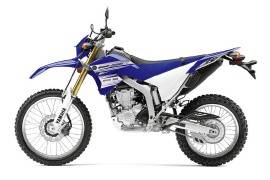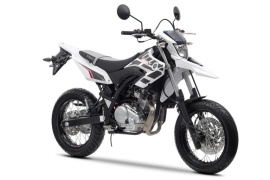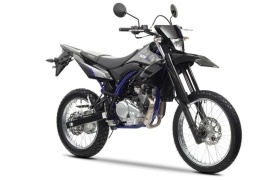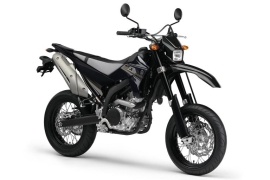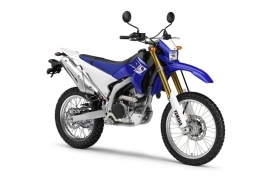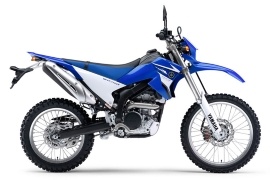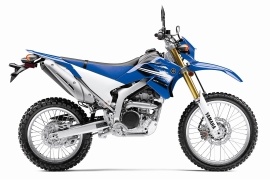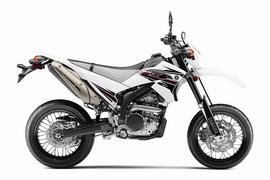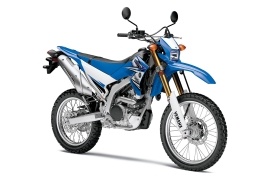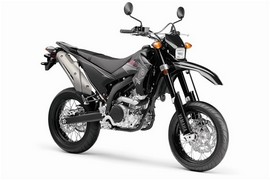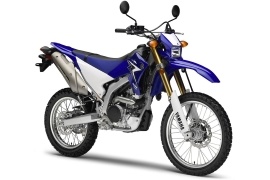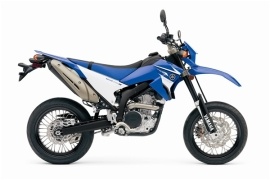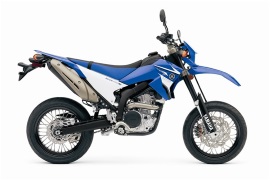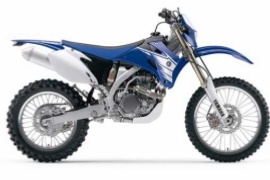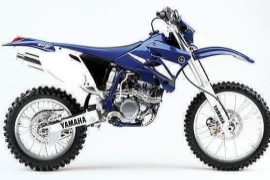YAMAHA WR Models/Series Timeline, Specifications & Photos
First production year: 2000
The Yamaha WR250R was a dual-sports motorcycle manufactured by Yamaha since 2008. The bike was part of the WR series that comprised models with different engine displacements.
The Yamaha WR250R had at its core a 249cc four-stroke single-cylinder liquid-cooled engine with a fuel injection system. It remained essentially unchanged over its production period, except for minor cosmetic modifications.
Alongside the WR250R, Yamaha made available the WR250X, a similar motorcycle fitted with more street-oriented tires and sprockets. The WR suffix pointed towards a wide-ratio gearbox that offered low-speed responsiveness in off-road situations but was also excellent at highway speeds.
In 2017, Yamaha released the WR250R, a dual-sports machine with the exact technical and power specifications as its predecessors. The bike was part of the WR series, alongside other motorcycles with different engine displacements.
The 2017 motorcycle was equipped with standard features, including a high-mounted front fender, fork covers, a small fairing, a single seat, an upswept exhaust system, a side stand, and lightweight wire-spoke wheels with off-road tires.
In the safety department, the bike packed the same braking system as previous models, including a dual-piston caliper with a 250 mm disc on the front and a single-piston caliper with a 230 mm disc on the rear wheel for excellent stopping power.
As for suspension, the bike's riding was softened by a 46 mm adjustable Kayaba inverted telescopic fork on the front with 270 mm wheel travel and a fully-adjustable piggyback absorber on the rear.
In 2016, Yamaha released the WR450F, an off-road machine that marked the beginning of the sixth generation. The bike was part of the WR series in Yamaha's range, comprised of off-road motorcycles with different engine displacements.
The 2016 motorcycle featured the reverse slant, four-valve per cylinder, fuel-injected engine that was previously used on the Yamaha YZ450F model since 2010. In addition, the Japanese maker introduced the new YZ450FX, a more enduro-oriented machine.
The 2016 WR450F motorcycle came with standard features, including fork covers, an engine guard, a high-mounted front fender, a side stand, a small front cowl with a small headlight, an under-seat exhaust system, and lightweight aluminum wheels.
The 2017 Yamaha WR450F remained virtually unchanged, except for minor modifications to the air box cover and wheel color changes from silver to black. The 2018 model was no longer available to be registered as a green sticker in California and also dropped the kick starter.
The 2019 model came with a more powerful engine and an updated frame. In addition, the bike also dropped the kick starter and included other changes, such as a more compact frame, a new speed sensor, a larger fuel tank, and an easy-access airbox.
The 2021 Yamaha WR450F model packed a new cylinder head, camshafts, piston, connecting rods, and a revised chassis.
In 2016, the Japanese motorcycle manufacturer launched the Yamaha WR250R, a dual-sports machine part of the WR series that comprised motorcycles with different displacement engines.
Over its production period, the Yamaha WR250R featured only minor cosmetic changes without significant modifications. The bike was fitted with a wide-ratio transmission with excellent low-speed responsiveness on off-road roads but also very responsive at highway speeds.
The 2016 Yamaha WR250R packed standard features in the appearance department, including a high-mounted front fender, a small cowl with a small rectangular headlight, a single seat, an upswept exhaust system, and wire-spoke wheels with off-road tires.
Not much was changed in the suspension department, packing the same system as its predecessors, with a 46 mm inverted Kayaba fork on the front and a fully-adjustable piggyback shock absorber on the rear.
Also, in the braking department, the bike retained the dual-piston caliper with a 250 mm disc on the front wheel and the single-piston caliper with a 230 mm disc on the rear wheel of previous models, delivering strong braking performance.
The 2016 Yamaha WR250R was powered by a 249cc single-cylinder liquid-cooled fuel-injected engine with 30 hp at 10,000 rpm available at the rider's wrist and 24 Nm (18 lb-ft) torque at 8,000 rpm.
The bike's power was handled by a six-speed manual transmission, sending it to the rear wheel through a final chain drive, launching the bike to 132 kph (82 mph).
With X in the name tag, it's obvious that the 2012 Yamaha WR125X is not a toy for the faint of heart. This bike was made for street aggression, and street aggression it will deliver: if a nimble small-displacement bike with plenty of punch and exceptional streetability is the name of your game, then you're looking at one of the best toys around. Light and with perfect, precise steering, the 2012 WR125X is the perfect bike to slice the busy city traffic, for daily commuting and various errands, while retaining the win-factor when a track weekend dawns.
Grippy sporty tires, revised suspensions and a less fatiguing, upright riding stance favor the bold riders and provide an intense thrilling experience. Adding in the inexpensive running costs, the 2012 Yamaha WR125X looks like one of the best ways to dominate the urban jungle.
The smallest of the WRs, the 2012 WR125R is a great way used by Yamaha to show to the world that small-displacement is indeed a great class which should not be easily overlooked. The full-size enduro bike was engineered to handle pretty much anything you might trow at it and keep on going just the same after the asphalt ends, through the gravel-paved roads and along the forest trails and fire roads.
Fuel injection makes sure the 124.7cc liquid-cooled engine is fed perfectly and will start easily regardless of altitude or temperature. Choosing 21" front and 18" rear wheels is self-explanatory: the 2012 Yamaha WR125R is not a joke. Large-diameter wave rotors provide all the stopping force needed to slow down when the rolling gets too fast.
In 2013, Yamaha released the WR250X, a dual-sports motorcycle part of the WR series in Yamaha's range that included motorcycles with different engine displacements. The bike debuted in 2008 alongside its off-road-oriented WR250R sibling.
Both machines were powered by the same single-cylinder engine and fitted with a wide-ratio transmission, delivering excellent low-speed responsiveness in off-road conditions and great capabilities at highway speeds.
The differences between the two motorcycles were the more street-oriented tires, sprockets of the X model, and the blacked-out front fork, frame, and swingarm. Over its production period, the WR250X remained essentially unchanged, without any significant changes, except for minor cosmetic changes.
In the appearance department, the 2013 Yamaha WR250X packed a high-mounted front fender, a small fairing, a front cowl with a rectangular headlight, a single seat, an upswept exhaust system, and wire-spoke wheels with black rims.
As for power, the 2013 Yamaha WR250X took its muscles from a 249cc single-cylinder liquid-cooled fuel-injected engine, delivering an output power of 30 hp with a peak at 10,000 rpm and 24 Nm (18 lb-ft) torque at 8,000 rpm.
The bike's power was handled by a six-speed manual transmission and a final chain drive that spun the rear wheel to a top speed of 140 kph (87 mph).
In the braking department, the wire-spoke wheels were fitted with a 298 mm disc, a dual-piston caliper on the front, and a single-piston caliper with a 230 mm disc on the rear.
The Yamaha WR250 was a dual-sports machine manufactured from 2008, alongside its WR250X sister model, a similar machine with more street-oriented tires and sprockets. Both motorcycles featured a wide-ratio transmission that delivered excellent low-speed response but also excellent at highway speeds.
In 2013, Yamaha released the WR250R, a lightweight off-road motorcycle, in its sixth consecutive year of production, which over the years, remained essentially unchanged from previous models, except for minor cosmetic modifications.
The bike had at its core a 250cc Liquid-cooled single-cylinder engine with an electronically controlled fuel injection system, lightweight titanium intake valves, a magnesium cylinder head, and a 16-bit ECU that delivered fast engine response.
In the performance department, the 2013 Yamaha WR250R packed underneath its small fairing, a 249cc liquid-cooled single-cylinder fuel-injected engine with 30 hp on tap at 10,000 rpm and 24 Nm (18 lb-ft) torque with a maximum peak force at 8,000 rpm. The bike was set in motion by a six-speed manual transmission with a final chain drive, pushing the machine to 132 kph (82 mph).
In the braking department, the WR250R packed a single-piston caliper with a 230 mm disc on the rear wheel and a dual-piston caliper with a 250 mm disc on the front wheel, offering strong stopping power.
For suspension, the bike featured a 46 mm adjustable inverted Kayaba fork on the front with 280 mm wheel travel and a fully-adjustable piggyback shock absorber on the rear with 270 mm wheel travel, delivering excellent suspension performance and handling.
In 2013, the Japanese maker launched the Yamaha WR250R, a dual-sports machine in its sixth year of production. Over its production period, the bike didn't feature any significant modifications except for minor cosmetic changes.
The Yamaha WR250R debuted in 2008 alongside its WR250X sister model that packed more street-oriented tires and sprockets. The bikes were fitted with a wide-ratio transmission with excellent low-speed responsiveness and equally great at highway speeds.
The bike was powered by a 250cc DOHC single-cylinder fuel-injected engine that featured lightweight titanium intake valves, a lightweight magnesium cylinder head, and a compact 16-bit Electronic Control Module (ECU) for fast engine response.
As for the power figures, the Yamaha WR250R boasted 30 hp with a peak at 10,000 rpm and 24 Nm (18 lb-ft) torque at 8,000 rpm from a 249cc liquid-cooled single-cylinder engine. The engine power was handled by a six-speed manual transmission and sent to the rear wheel through a final chain drive, pushing the bike to a top speed of 132 kph (82 mph).
In the suspension department, the bike packed a 46 mm adjustable Kayaba inverted fork on the front with 280 mm wheel travel and a piggyback shock absorber on the rear with 270 mm wheel travel.
As for braking performance, the 2013 Yamaha WR250R rolled on wire-spoke wheels with a dual-piston caliper, a 250 mm disc on the front, and a single-piston caliper with a 230 mm disc on the rear.
The Yamaha WR250R was a dual-sports machine introduced by the Japanese maker in 2008, powered by a single-cylinder DOHC fuel-injected engine. The bike was part of the WR series that comprised motorcycles with different engine displacements.
In 2012, Yamaha released the WR250R, a lightweight off-road machine in its fifth year of production that didn't bring any significant modifications whatsoever, except for minor cosmetic changes.
For appearance, the bike packed a high-mounted front fender, fork covers, a small cowl with a rectangular headlight, a single seat with a slim profile, a silver-finished aluminum frame, a half fairing, and wire-spoke wheels with off-road tires.
In the performance department, the 2012 Yamaha WR250R packed the same 249cc liquid-cooled single-cylinder fuel-injected engine as previous models, delivering an output power of 30 hp with a maximum peak force at 10,000 rpm and 24 Nm (18 lb-ft) torque at 8,000 rpm.
In the suspension department, the bike's ride was softened by a fully-adjustable piggy-back shock absorber on the rear and a 46 mm adjustable Kayaba inverted fork on the front with 280 mm wheel travel, providing excellent suspension and handling performance.
As for the stopping power, the 2012 Yamaha WR250R rolled on a set of lightweight wire-spoke wheels fitted with a dual-piston caliper, a 250 mm disc on the front, and a single-piston caliper with a 230 mm disc on the rear.
In 2012, Yamaha launched the WR250X, a more street-oriented version of the WR250R motorcycle. Both machines were part of the WR series and packed many similarities but also a few different features.
Compared to the WR250R off-road-dedicated machine, the WR250X was a more street-oriented model with street tires and sprockets. In addition, in the appearance department, the WR250X came with a blacked-out front fork, frame, and swingarm.
The 2012 Yamaha WR250X was fitted with standard features, including a high-mounted front fender, a small cowl with a rectangular headlight, a small fairing, a single seat, fork covers, and wire-spoke wheels with street tires and black rims.
The bike debuted in 2008 alongside its off-road sibling and remained essentially unchanged over its production period, without any significant modifications, except for minor cosmetic changes.
The 2012 Yamaha WR250X took its power from a 249cc single-cylinder liquid-cooled engine fitted with an electronically controlled fuel injection system, delivering an output power of 30 hp at 10,000 rpm and 24 Nm (18 lb-ft) torque at 8,000 rpm.
The bike's suspension was handled by a 46 mm fully-adjustable inverted fork on the front and a fully-adjustable shock absorber on the rear, delivering excellent suspension performance and handling.
In the braking department, the 2012 Yamaha WR250X was fitted with a dual-piston caliper, a 298 mm disc on the front wheel, and a single-piston caliper with a 230 mm disc on the rear wheel, delivering robust and reliable stopping power.
In 2011, Yamaha launched the WR250R, a dual-sports motorcycle manufactured by Yamaha from 2008, part of the WR series and powered by a 250cc single-cylinder DOHC engine with an electronically controlled fuel injection system.
The bike was built alongside the WR250X, packed with more street-oriented tires and sprockets. The WR suffix indicated that the bike features a wide-ratio transmission for low-speed responsiveness in off-road conditions but also handling highway speeds.
In the appearance department, the 2011 Yamaha WR250R featured a high-mounted front fender, a small cowl with an LED headlight, a single seat, a slim profile, an upswept exhaust system, and wire-spoke wheels with off-road tires.
The bike's wire-spoke wheels were fitted with a dual-piston caliper, a 250 mm disc on the front, and a single-piston caliper with a 230 mm disc on the rear, offering excellent stopping power.
As for suspension, the bike's ride was softened by a 46 mm adjustable Kayaba inverted fork on the front with 270 mm wheel travel. The rear end was operated by a fully-adjustable piggyback shock absorber with 270 mm wheel travel, delivering excellent handling.
As for the power figures, the 2011 Yamaha WR250R boasted 30 hp on tap at 10,000 rpm and 24 Nm (18 lb-ft) torque at 8,000 rpm from a 249cc four-stroke liquid-cooled single-cylinder engine.
The engine power was handled by a six-speed manual transmission and delivered to the rear wheel through a final chain drive.
The Yamaha WR250X was a dual-sports motorcycle manufactured by Yamaha from 2008 alongside its more off-road-oriented WR250R sibling. Both machines were part of the WR series and shared many design and technical elements.
The WR suffix indicated a wide-ratio transmission that delivered excellent low-speed responsiveness in off-road situations but also with great abilities at highway speeds. Over its production period, the bike featured only minor cosmetic changes without significant modifications.
In the appearance department, the WR250X packed standard features, including a single seat, a small fairing, a rectangular headlight in a small front cowl, fork covers, a side stand, an upswept exhaust system, and wire-spoke wheels with street-oriented tires and sprockets.
Compared to the WR250R off-road machine, the X model had more blacked-out elements, including the front fork, frame, and swingarm. In addition to the street-oriented tires, the bike featured wire-spoke wheels with black-finished rims.
For safety, the bike was fitted with a dual-piston caliper and a 298 mm disc mounted on the front wheel and a single-piston caliper with a 230 mm disc mounted on the rear wheel, delivering strong stopping power.
The bike's suspension was handled by a 46 mm fully-adjustable inverted fork on the front and a fully-adjustable single shock absorber on the rear, offering excellent suspension performance and handling.
In the power department, the 2011 Yamaha WR250X took its muscles from a 249cc liquid-cooled single-cylinder engine fed by an electronically controlled fuel injection system, delivering an output power of 30 hp with maximum thrust at 10,000 rpm and 24 Nm (18 lb-ft) torque at 8,000 rpm.
The Yamaha WR250R was a dual-sport motorcycle part of the WR series in Yamaha's range, comprising models with different engine displacements. The bike debuted in 2008 and was powered by a 250cc single-cylinder DOHC engine.
In 2010, Yamaha launched the WR250R, a machine in its third year of production that didn't bring any changes whatsoever. The bike was fitted with a wide-ratio six-speed transmission with excellent low-speed responsiveness but also delivered an outstanding performance at highway speeds.
The 2010 Yamaha WR250R came from the factory equipped with standard features, including a high-mounted front fender, fork covers, a small cowl with an LED headlight, a single seat, and lightweight wire-spoke wheels.
For suspension, the bike was fitted with a 46 mm adjustable Kayaba fork on the front with 280 mm wheel travel and a fully-adjustable shock absorber on the rear with 270 mm wheel travel, delivering excellent suspension and handling performance.
As for the stopping power, the bike was fitted with a dual-piston caliper, a 250 mm disc on the front, and a 230 mm disc with a single-piston caliper on the rear, offering robust and reliable braking performance.
In the power department, the 2010 Yamaha WR250R packed the same 249cc liquid-cooled single-cylinder engine fed by an electronically controlled fuel injection system, boasting 30 hp on tap at 10,000 rpm and 24 Nm (18 lb-ft) torque at 8,000 rpm.
In 2010, the Japanese motorcycle manufacturer released the Yamaha WR250X, a dual-sports machine in its third year of production that didn't feature any modifications whatsoever. The bike was part of the WR series in Yamaha's range and almost identical to the WR250R off-road motorcycle.
Compared to the more off-road-oriented motorcycle, the WR250X packed street tires and sprockets but also featured some cosmetic differences, including a blacked-out front fork, frame, and swingarm.
The 2010 Wr250X came equipped with standard features right from the factory, such as a single seat, a small front cowl with a rectangular headlight, a small fairing, a side stand, and lightweight wire-spoke wheels with blacked-out rims.
In the power department, the WR250X packed the same 249cc single-cylinder liquid-cooled engine as its sibling, with an electronically controlled fuel injection system, delivering 30 hp with a peak at 10,000 rpm and 24 Nm (18 lb-ft) torque at 8,000 rpm.
The bike's ride was softened and handled by a 46 mm fully-adjustable inverted fork on the front and a fully-adjustable single shock absorber on the rear, providing excellent suspension performance and handling.
In the braking department, the 2010 Yamaha WR250X was fitted with a 298 mm disc and a dual-piston caliper on the front wheel and a 230 mm disc with a single-piston caliper on the rear wheel, with excellent stopping power capabilities.
In 2009, the Japanese motorcycle maker released the Yamaha WR250R, a dual-sport machine part of the WR series in Yamaha's range. The bike debuted in 2008 and was in its second year of production without any modifications.
The bike and other machines with different engine displacements were part of the WR series. The WR suffix pointed towards a wide-ratio transmission with excellent low-speed response in off-road conditions but also excellent at highway speeds.
The 2009 Yamaha WR250R was fitted with standard features, such as an upswept exhaust system, a high-mounted front fender, a single seat, a small headlight in a small cowl, fork covers, and lightweight wire-spoke wheels.
The bike was built on a semi-double-cradle aluminum frame with a 46 mm adjustable inverted Kayaba cartridge-type fork on the front and a fully adjustable piggyback shock absorber on the rear, delivering excellent suspension performance and handling.
The bike's wire-spoke wheels were fitted with a 250 mm fully floating disc, a dual-piston caliper on the front, and a single-piston caliper with a 230 mm disc on the rear, delivering strong braking performance.
The 2009 Yamaha WR250R took its muscled from a 249 cc four-stroke liquid-cooled single-cylinder engine with an electronically controlled fuel injection system, delivering an output power of 30 hp at 10,000 rpm and 24 NM (18 lb-ft) torque at 8,000 rpm.
The Yamaha WR250X was a motorcycle manufactured by Yamaha from 2008, part of the WR series and almost identical to the WR250R. Some differences between the two models were minor cosmetic changes and the more street-oriented tires and sprockets of the X model.
The bike debuted in 2008, and over its production period, it didn’t feature any significant modifications except for minor cosmetic changes. The bike was capable of competing in Supermoto events in the factory package and was manufactured for those riders who spent more time on paved roads.
The bike was fitted with standard features, such as a high-mounted front fender, a single seat, a small fairing, a small front cowl with a rectangular headlight, a side stand, and lightweight wire-spoke wheels with road tires.
In the performance department, the bike was fitted with the same 249cc single-cylinder liquid-cooled engine as its WR250R sibling, delivering the same power of 30 hp with a maximum peak force at 10,000 rpm and 24 Nm (18 lb-ft) torque at 8,000 rpm.
For suspension, the bike was fitted with a 46 mm fully-adjustable inverted fork on the front and a fully-adjustable shock absorber on the rear, offering excellent suspension performance and handling.
The 2009 Yamaha WR250X was fitted on its wire-spoke wheels with a single-piston caliper, a 230 mm disc on the rear, and a dual-piston caliper with a 298 mm disc on the front, providing excellent stopping power.
The Yamaha WR250R was a dual-sport motorcycle manufactured by Yamaha from 2008, powered by a 250cc liquid-cooled single-cylinder engine fed by an electronically controlled fuel injection system.
Over its production period, the bike remained essentially unchanged, except for cosmetic modifications, along with its WR250X sister model, which was a more street-oriented machine with different tires and sprockets.
The WR suffix indicated a wide-ratio transmission designed for excellent low-speed response in off-road conditions but also excellent at highway speeds. The 2020 model marked the last production year for the WR250R.
Right from the factory, the WR250R came equipped with standard features, such as a high-mounted front fender, an upswept exhaust system, a side stand, a small cowl with a tiny headlight, a single seat, and lightweight wire-spoke wheels.
For power, the 2008 Yamaha WR250R packed a 249cc four-stroke single-cylinder liquid-cooled engine, boasting 30 hp with a maximum peak force at 10,000 rpm and 24 Nm (18 lb-ft) torque at 8,000 rpm.
For stopping power, the bike had fitted a 250 mm fully floating wave-style disc engaged by a dual-piston caliper on the front wheel. In contrast, the rear wheel was stopped by a 230 mm wave-style disc with a single-piston caliper.
The ride was softened by a 46 mm adjustable inverted Kayaba fork on the front and a fully adjustable piggyback shock absorber on the rear, offering excellent suspension performance in off-road situations.
In 2008, alongside the WR250R, the Japanese motorcycle maker made available the Yamaha WR250X, an identical machine fitted with more street-oriented tires and sprockets. The bike was also part of the WR series in Yamaha's range, which comprised motorcycles with different engine displacements.
The WR250X was not just a dressed-up sports motorcycle, but it was capable of competing in Supermoto events right from the box. The bike was derived from the YZ and WR off-road machines and manufactured for those riders who spent more time on paved roads.
Right from the factory, the WR250X was slightly different from the WR250R in the appearance department, featuring a black front fork, frame, swingarm, and different tires and sprockets.
The bike came with standard features, including a high-mounted front fork, a small front cowl with a rectangular headlight, a single seat, an upswept exhaust system, a side stand, and lightweight wire-spoke wheels.
In the braking department, the WR250X packed a dual-piston caliper with a 298 mm disc on the front wheel and a single-piston caliper with a 230 mm disc on the rear, delivering solid and reliable stopping power.
For suspension, the bike featured a fully-adjustable 46 mm inverted fork on the front and a fully-adjustable single shock absorber on the rear, delivering excellent suspension and handling performance.
As for performance, the 2008 Yamaha WR250X was powered by a 249cc single-cylinder liquid-cooled engine that delivered an output power of 30 hp at 10,000 rpm and 24 Nm (18 lb-ft) torque at 8,000 rpm.
In 2003, the Japanese maker released the Yamaha WR450F, an off-road motorcycle that debuted in 1998 under the WR400F designation. The bike shared many design concepts and components with the Yamaha YZ400F motocross machine.
The fourth generation of the WR450F began with the 2007 model, which gained an aluminum frame that slightly reduced the overall weight. The 2007 model also got a revised engine with a new balancer, cylinder head, and camshafts.
The fourth generation was manufactured from 2007 to 2011, and the 2009 WR450F model received new graphics, while the 2010 machine was not sold in the United States market.
The 2012 WR450F marked the beginning of the fifth generation and included some modifications, such as a 2012 YZ450F frame, a KYB SSS front fork, a fuel injection system, and a modified engine position, rotated backward for a new center of gravity and handling improvement.
The 2003 Yamaha WR450F was powered by a 449cc liquid-cooled four-stroke single-cylinder engine that delivered 58 hp with a peak at 9,000 rpm and 49 Nm (36 lb-ft) torque at 7,000 rpm.
The bike's braking power was achieved by a four-piston caliper with a 250 mm disc mounted on the front wheel and a dual-piston caliper with a 245 mm disc mounted on the rear wheel, delivering excellent stopping power.
As for suspension, the bike's riding was softened by a 46 mm inverted Kayaba fork with compression and rebound adjustability on the front and a fully-adjustable Kayaba shock absorber on the rear.
The Yamaha WR250F was an off-road motorcycle manufactured by Yamaha, featuring a 250cc liquid-cooled nikasil-coated single-cylinder engine. The bike was first offered in 2001 and packed many similar components to the Yamaha YZF250F motocross machine.
It was basically a slightly detuned version of the YZ250F with more controllable power, a headlight and lighting coil, softer suspension, a kickstand, a larger radiator, better noise specifications, and fewer emissions.
The bike was a modified YZ250F for enduro competitions, extreme enduro competitions, and hard enduro competitions. Over its production period, the motorcycle featured several modifications, including an aluminum frame and improved suspension.
The WR, in its name, pointed towards a wide-ratio transmission, commonly used on most enduro and trail bikes, compared to the close-ratio gearbox essential to a motocross machine.
The 2001 Yamaha WR250F was powered by a 249cc four-stroke liquid-cooled single-cylinder engine that delivered the power to the rear wheel through a five-speed manual transmission and a final chain drive.
The bike's riding was softened by a 48 mm fully-adjustable inverted fork on the front with 300 mm wheel travel and a fully-adjustable link-type shock absorber on the rear that offered 305 mm wheel travel.
In the braking department, the bike's wire-spoke wheels were fitted with a dual-piston caliper, a 250 mm disc on the front, and a single-piston caliper with a 240 mm disc on the rear, delivering excellent stopping power.


